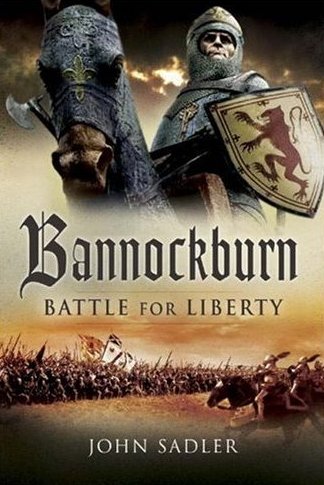
De Re Militari | Book Reviews
John Sadler
Bannockburn: Battle for Liberty
Barnsley, South Yorkshire: Pen & Sword, 2008. 174 pp. £19.99. ISBN 978-184415673-7.
Readers acquainted with John Sadler’s Border Fury: England and Scotland at War, 1296-1568 (Harlow: Pearson-Longman, 2005) will find themselves in familiar surroundings in the author’s latest book, Bannockburn: Battle for Liberty. The similarity is so striking that pages 30 through 90 and 109-33 in Bannockburn are essentially identical with pages 52-123 and 125-54, respectively, of Border Fury Sadler’s text in Bannockburn has been expanded when dealing with the battle fought between Scottish and English forces on 23-24 June 1314 which came to be known as Bannockburn. Both books are narratives of Anglo-Scottish conflict, with that of Bannockburn covering the reigns of the English kings Edward I (reigned 1272-1307) and Edward II (reigned 1307-27).
It is not a good omen for Bannockburn when on the first page we are told that Robert Bruce, the victorious commander at Bannockburn and the future King Robert I of Scotland, was born in 1374 (meaning 1274) while in the line directly above the error it is noted that he died in 1329. On the same first page of the narrative, mention is made of the 1996 exhumation of the remains of Robert Bruce and that a forensic sculpture was made based upon the skull. The same forensic sculpture technique is noted on page 157 of Border Fury, but a reader will look in vain in either book for a photograph of the sculpture. Sadler refers on page 18 of Bannockburn to two martial drawings in the Holkham Bible Picture Book, dated c.1320-30, but they are not reproduced. The illustrations in Bannockburn consist of photographs of modern statuary and scenes of the supposed battlefield as it now appears. There is also a photograph of an undated horseman’s axe, together with photographs of replicas of fourteenth-century weaponry; the most curiously presented being a photograph of a mail shirt replica hanging from the back of a chair placed atop a table. The two maps depicting each of the two days of the battle of Bannockburn have a quaint appearance, but they are not easily followed. Just what is meant by the sub-title “Battle for Liberty” is never explained. Perhaps Sadler means the struggle to resist English overlordship of Scotland, but if so, his intent is unclear.
There are also quite a few problems with the text. Sadler seems unsure about the siege of Stirling Castle initiated by Edward Bruce, earl of Carrick and brother of Robert Bruce, in March or April 1314 when Edward II was preparing for an invasion of Scotland (p. 80). [For the chronology of events leading up to the battle of Bannockburn, Sadler would have benefited from consulting A. A. Duncan, “The War of the Scots, 1306-1323,” Transactions of the Royal Historical Society, Sixth Series, 2 (1992): 125-51.] Military historians, who continue to debate the chronology for English archers taking up the longbow, will find it curious that Sadler takes it as fact that the ineffectively deployed archers in the English army at Bannockburn were using longbows as opposed to short bows (see pp. 16, 21, 23-24, 92, 102). As to the course of events in the fighting on those two days in June 1314, Sadler is also more confident about how matters unfolded than most military historians, who are cautious and who consider more than one plausible sequence of events.
Sadler holds a derisive if not salacious opinion of Edward II, the commander of the English forces that met with defeat at Bannockburn. Where modern historians have strong reservations about King Edward’s bi-sexuality because there is no contemporary evidence for it, Sadler has no doubts. Piers Gaveston (d. 1312), who Edward unwisely promoted to great power, is for Sadler Edward’s catamite (pp. 71, 74) and lover (p. 74). Hugh Despenser the Younger (d. 1326), another of Edward’s unwisely promoted associates, is likewise a catamite (p. 136) and Edward’s paramour (p. 135). As might be expected, Edward’s queen and the mother of his legitimate children, Isabella of France (d. 1358), is characterized as a she-wolf (p. 134). For King Edward and the people and events of his life, Sadler would have been aided through a reading of Roy Martin Haines, King Edward II: Edward of Caernarfon, His Life, His Reign, and Its Aftermath (Montreal & Kingston: McGill-Queen’s University Press, 2003).
This reviewer will not place Sadler’s Bannockburn on his list of readings for his students. That place on the list will be taken by David Cornell, Bannockburn: The Triumph of Robert the Bruce (New Haven & London: Yale University Press, 2009).
